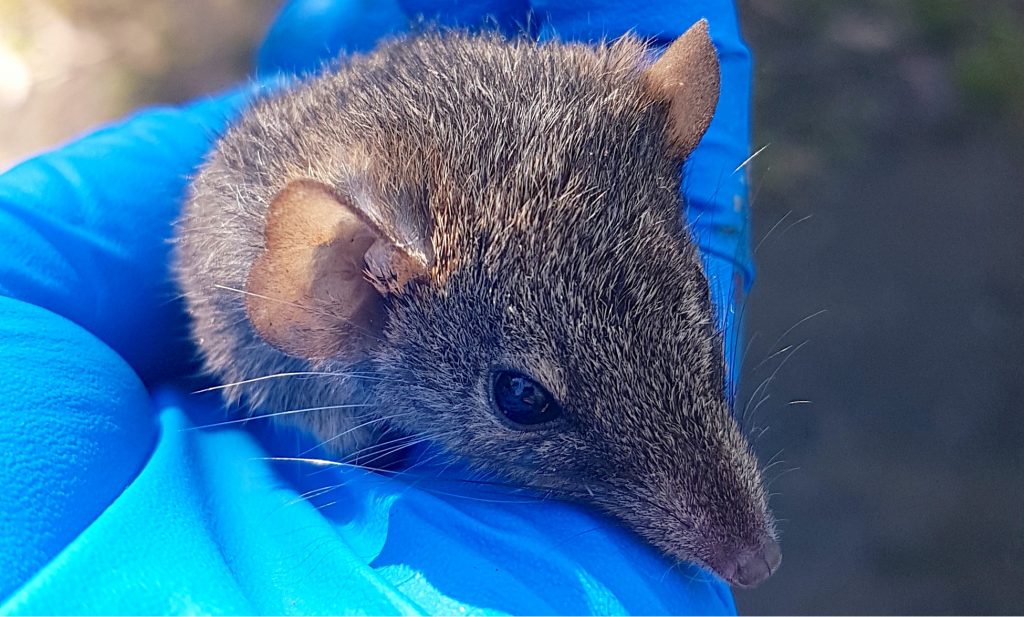Q&A with Parice Brandies on the Antechinus Genome

With the recent launch of our new GigaByte journal you may have noticed some interesting genome datasets being published, including the banjo frog, common dragonet fish, and extremely rare Nyssa yunnanensis tree. Joining these species on the genomics tree of life this month is a small mouse-like marsupial called the brown antechinus. While upon first glance many would just assume it was shrew, upon deeper inspection it has a number of extremely interesting and unique biological features that has led it to be the 7th marsupial sequenced. To explain more, first author Parice Brandies from the School of Life and Environmental Sciences at the University of Sydney in Australia gives one of our GigaBlog Q&A’s. You can also hear from Parice in person in a video abstract, following from a similar feature from the author of the banjo frog.
What are Antechinus, and what inspired you to sequence the brown antechinus genome?
Antechinus are a genus of small, mouse-like marsupials comprising 15 species that are mainly distributed along the Great Dividing Range of Australia. The brown antechinus (Antechinus stuartii) is one of the most common mammals of eastern Australia and is also one of the best studied antechinus species. Antechinus possess a number of unique biological characteristics that warrant further investigation and hence inspired us to sequence the first antechinus reference genome.
Firstly, antechinus are one of the only mammalian species that exhibit the rare reproductive strategy known as semelparity where a complete die-off of all males occurs after each breeding season due to an extreme resource shift from immunity and survival to reproduction. This unique life-history trade-off makes the antechinus an ideal model to investigate the interplay between key biological processes and how these interactions are controlled at the genetic level.
Secondly, male and female antechinus have been found to develop age-related neuropathologies that are very similar to those seen in humans. A current limitation of utilising mouse models for neurodegenerative disorders like Alzheimer’s disease is the fact that mice don’t naturally produce human-like neuropathologies. The characteristics of the brown antechinus could make this species a potentially more ideal model for studying the development and genetic risk factors of neurodegeneration in humans.
We hope that our newly sequenced reference genome inspires further exploration into the interesting biological phenomena of the antechinus.

There are a number of projects (EBP, G10K, VGP, etc.) systematically studying the genomes of the different corners of the tree of life, both taxonomically and geographically. Where do Australian species such as this fit into these efforts, and how important do you think it is to sample and include Australian biodiversity in these projects?
Since Australia has been geographically separated for many millions of years, we hold a wealth of unique biodiversity that cannot be found anywhere else in the world. Being one of 17 megadiverse countries, Australia holds a large proportion of the Earth’s species and many of these species are taxonomically important, often being the only extant members in particular phylogenetic lineages within the tree of life. Unfortunately, Australia also has the worst mammal extinction rate out of any country and therefore a better understanding of our weird and wonderful Australian species is crucial to conserving our biodiversity.
Both national and international genome sequencing projects have recognised the importance of Australian species and the value of their genomic data. In particular, Bioplatforms Australia is facilitating the creation of reference genomes for a wide variety of native plant and animal species through initiatives like Oz Mammals Genomics (OMG), Australian Amphibian and Reptile Genomics (AusARG), Genomics for Australian Plants (GAP) and the Threatened Species Initiative (TSI).
It is an exciting prospect to be able to use genomics to unlock the hidden potential within Australia’s biodiversity and we look forward to seeing the implications of these new genomic resources in the years to come.
What are your further plans for the project and what do you hope others will do with this data?
Now that an antechinus reference genome is available, we would love to delve deeper into the genetics behind mammalian semelparity and how this may have implications for other species. For example, previous research has shown that elevated levels of corticosteroids during the breeding season are predicted to maximise reproductive effort in the male antechinus during the breeding season by freeing up energy reserves, despite the consequences of complete immune system collapse and eventually death. A better understanding of how this extreme process is controlled at the genetic level could one day be applied to other species, such as those of conservation concern, where a tight balance between stress, immunity and reproduction is crucial to species survival. Hence, a fundamental next step would be to monitor changes in gene expression across the breeding season of the antechinus to determine key genes that may modulate this process.
We also hope that other researchers will utilise the genome to further explore the potential of employing antechinus as a natural model for age-related neurodegenerative processes and investigate genetic risk factors that may be applicable to human disease.
This is the first paper we’ve taken from the start to the end of the new GigaByte publication pipeline. Being mostly automated, the editorial production and proofing part took us about 8-hours, and we’ve tried to streamline the peer review too with a questionnaire-based review process. Overall how did you find the publication process and how important was it to you to get genome studies like this out quickly and relatively painlessly?
We were thrilled to be the first paper to test out GigaByte’s publication pipeline and to be one of the first studies published in this seminal new journal. Overall, the publication process was very smooth and efficient. The questionnaire-based review process enabled suggested revisions to be clearly stated, implemented, and responded to with ease. The ability to publish any related datasets with GigaDB (e.g. the data from this study here) is also a great advantage and the upload process is fast and simple.
With the sheer volume of genome studies currently underway, journals which not only enable researchers to focus on the details of the genomic resource, but also allow for rapid release of these publications and associated data will be invaluable. The faster new genomic resources are published, the faster other researchers can utilise the data to explore their own insightful questions in their respective field of interest, making journals like GigaByte a key player in broadening the scope and implications of initial genome studies. The modern feel of GigaByte’s website and implementation of nifty features for both the authors and readers also get a big tick of approval!
You can watch a video abstract of Parice talking about her research on our youtube channel and embedded below. Submit your genome and other data and software papers now to take advantage of free Article Processing Charges until early-2021.
References
Parice A. Brandies, Simon Tang, Robert S. P. Johnson, Carolyn J. Hogg, Katherine Belov, The first Antechinus reference genome provides a resource for investigating the genetic basis of semelparity and age-related neuropathologies, Gigabyte, 1:7, 2020 https://doi.org/10.46471/gigabyte.7